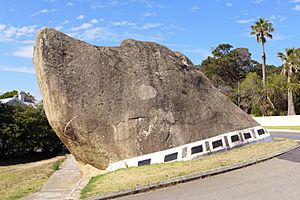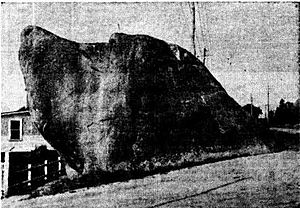Dog Rock facts for kids
Dog Rock is a giant, natural rock formation found in Albany, Western Australia. It's made of granite and is located along Middleton Road, between Middleton Beach and the town center. This famous landmark looks just like a dog's head when you see it from the western side, which is how it got its name!
Contents
Dog Rock: Albany's Famous Landmark
Dog Rock is a very well-known sight in the Great Southern region of Western Australia. Its unique shape makes it a popular stop for visitors exploring the area.
An Ancient Story: The Noongar Name
The local Aboriginal people, known as the Noongar people, have a special name for this rock: Yacka. This name means "wild dog tamed." Many believe it was an old marker for land boundaries. Local Aboriginal people do not camp near the rock or shelter under it, though the exact reason is not widely known.
Saving Dog Rock: A Community Effort
Imagine trying to blow up a famous rock! In 1921, the Albany Council actually suggested using explosives to remove Dog Rock. They wanted to make the road wider. But people were very upset about this idea! There were many protests and petitions. A big argument happened during a council meeting, and because of all the public outcry, the plan to destroy the rock was stopped.
Making it Safer: The White Collar
In 1938, the Royal Automobile Club said that Dog Rock was a danger to cars. This was because it stuck out onto the road. To make it easier for drivers to see, the local authorities painted a bright white "collar" around the bottom of the rock. This distinctive white band is still there today!
A New Home? Moving the Rock
In the 1960s, the manager of a local radio station, 6VA, had a very unusual idea. He thought Dog Rock should be moved! He suggested cutting the rock into pieces and then rebuilding it at a busy roundabout. He believed this would make it an even more central spot for tourists. However, this idea was never put into action.
Protecting Dog Rock for the Future
Dog Rock is an important part of Albany's history and landscape. In 1973, it was officially recognized by the National Trust. Later, in 2001, it was added to the local list of important places. This helps make sure that Dog Rock will be protected and enjoyed for many years to come.



